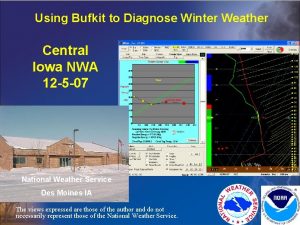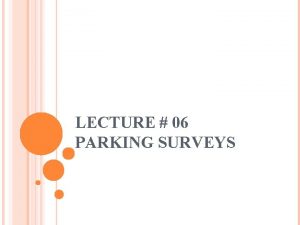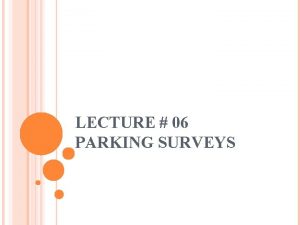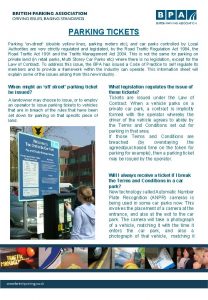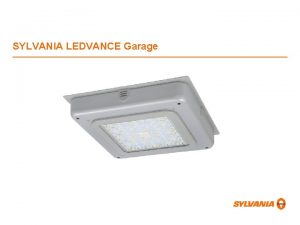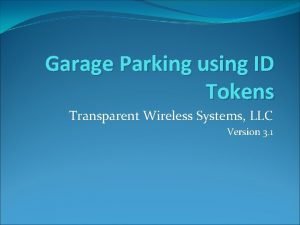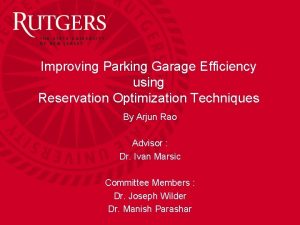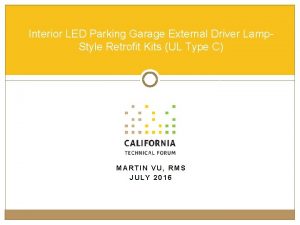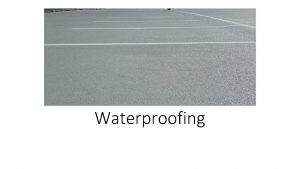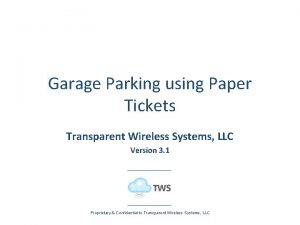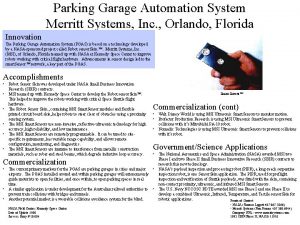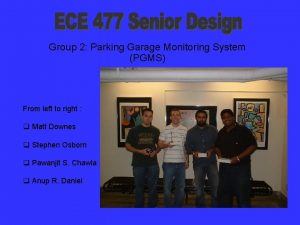Garage Parking Indicator Iowa State University Senior Design
































- Slides: 32

Garage Parking Indicator Iowa State University Senior Design Dec 06 -09 Faculty Advisor: Dr. Gary Tuttle Client: Senior Design Kevin Finck (EE) Lars Kulseng (Cpr. E) Richard Seals (Cpr. E) Daniel Wiltse (EE)

Outline Problem Description Problem Constraints and Assumptions Intended Users and Uses Technical Design Conclusion

Problem Description The goal is to provide a system to assist a person in parking a vehicle in a garage in two dimensions.

Constraints Device has to act as a suitable visual guide for the driver to ensure the vehicle is parked correctly One Device will provide guidance for two parking stalls Installation must be able to be performed by a single person in a small amount of time using only simple hand tools The system should activate automatically and turn off the position indicator after a short period of time The system should provide accurate information to any licensed driver regardless of age or height The system should be easy to manufacture and retail for less then $40

Assumptions The garage has a door and an electric door opener. There is a suitable mounting place for the device in the garage. The same vehicle will be parked in the same position every time. The garage door opener includes a standard incandescent light bulb which comes on when the door opener is activated. The unit has an unobstructed “line of sight” to the vehicle. Vehicle is parked forward into the garage.

Intended Users Anyone who owns a garage will be able to use this product. As long as the garage has walls or a ceiling the consumer will be able to install the device themselves. Conceptually the device could be placed in a large, multi level parking garage, but the product is primarily intended for private individuals. This product is intended to be an easy solution to help guide parking for any individual in need of parking assistance.

Intended Uses The device is intended to be used to help individuals park their vehicles in the correct position. The system should provide guidance to the driver entering the garage to assist in getting the vehicle in the correct position.

Technical Design Switching Control Installation/Mounting Operation and Usage

Technical Design Switching Control On and Off Control of the Laser Pointers – The design criteria of the product require automatic control for turning on and off of the laser pointers. This requirement results in: Extend life of the laser pointers Reduced possibility of accidental eye contact with the laser beams. Warning label required in documentation. Reduced energy consumption of the device – Laser pointers are only required to be on when the vehicle is entering the garage.

Technical Design Switching Control Approaches considered for controlling the power to the laser pointers include: – Laser beam trip wire sensor detecting the proximity of the vehicle – Sound detection sensor detecting the noise from the vehicle – Light sensor detecting change of light brightness when the garage door opens – Using the garage door opener to provide A/C power to the power supply – Vibration sensor detecting movement of the garage door opener mechanism

Technical Design Switching Control The two approaches chosen are: – Receive A/C power from the garage door opener light bulb fixture (Plan A) – Sensing vibration caused by the garage door opener mechanism (Plan B)

Technical Design Switching Control The garage door opener light socket approach (Plan A) was chosen for its simplistic and low cost design. The vibration sensor approach (Plan B) was chosen because it was felt it would have the lowest amount of false turn-on indications.

Technical Design Switching Control The parts for the vibration sensor method (Plan B) were ordered and received a week ago. The specific vibration sensor part was chosen for its low cost ≈ 4 dollars. Unfortunately, the vibration sensor part has been placed on backorder status by the manufacture (Omron) with an availability date of August 1. Because of the long wait for the vibration sensor part, the team is currently pursuing the garage door opener light bulb fixture approach (Plan A).

Technical Design Switching Control Light Bulb Fixture Approach (Plan A) – A. AC to DC Power supply and cable assembly to laser pointer main unit – B. Light bulb – C. Light bulb socket adaptor – D. Light bulb socket The light bulb fixture approach uses the timed power source of the light to turn the laser pointers on and off.

Technical Design Switching Control

Technical Design Switching Control Vibration Sensor Control Circuit Approach (Plan B) – The vibration sensor approach uses the mechanical vibration of the garage door opener to trigger the vibration sensor. The vibration sensor triggers the 555 timer circuit turning on the control relay which supplies power to the laser pointers. After capacitor C 2 has discharged, the circuit resets. The relay contacts open removing the power to the laser pointers

Technical Design Switching Control Vibration Sensor Control Circuit Approach (Plan B)

Technical Design Installation/Mounting – The parking indicator will be a single unit that is installed on the ceiling or back of the wall – Two lasers mounted on the outside of the unit will be pointed in a user defined direction – Lasers will be adjustable

Technical Design o Unit is placed Installation/Mounting between the parking stalls so the beam of the laser can be directed through the windshield of the vehicle to hit a target pad on the dashboard of the vehicle o The unit can be placed on the ceiling so the laser can be directed through the windshield of the vehicle

Technical Design Installation/Mounting o The unit can also be placed on the back of the garage wall o The user has to aim the laser in the area for both options on the dashboard to hit a target pad which will have a 2 inch accuracy for parking

Technical Design Installation/Mounting – A target pad will be placed on the dashboard of the vehicle to help the driver to determine if he or she is in the right position – The circle in the middle will serve as the target for the laser beam – When the laser is within the circle, the driver is within +/- 1 inch of the initial calibration point – The extensions on either side of the target pad will provide the driver guidance on how far the car is to the left or to the right. – The target pad will be made of a durable material that will stick to the dashboard without leaving a mark.

Technical Design Installation/Mounting Options – Adhesive Advantages – Easy to install – Readily available replacement parts Disadvantages – Not as long lasting as screws – Cannot be remounted as easily Rejected due to adhesive losing its strength after a period of time

Technical Design Installation/Mounting Options CONT. – Nails/screws Advantages – Long lasting – Readily available replacement parts Disadvantages – Holes in wall – Installation slightly difficult but achievable This method will be chosen due to mechanical durability

Summary The car will enter the garage The device will turn on automatically Laser beam will guide driver to correct position indicated by target pad The device will automatically turn off

Sideview of garage

Laser turns on automatically

Car is in correct position when laser hits target

Topview of target as car enters garage

The device will switch off automatically

Current Status Some parts are back-ordered from distributor Project is on schedule

Next Phase Conduct testing Decide on switching method Gather remaining parts Assembling parts

QUESTIONS?
 Estes park parking
Estes park parking Iowa state intramurals
Iowa state intramurals Isu accounts receivable office
Isu accounts receivable office University of iowa hospitals and clinics
University of iowa hospitals and clinics University of iowa college of dentistry
University of iowa college of dentistry Uihc billing
Uihc billing Teori perilaku studi universitas ohio
Teori perilaku studi universitas ohio Sona systems iowa state
Sona systems iowa state Isabel darcy
Isabel darcy Iowa high school mock trial
Iowa high school mock trial Hawkmail uiowa
Hawkmail uiowa Iowa state bufkit
Iowa state bufkit Iowas state tree
Iowas state tree Iowa state intramurals
Iowa state intramurals Iowa state snowmobile association
Iowa state snowmobile association Iowa mesonet
Iowa mesonet Iowa state geology
Iowa state geology Hixson lied student success center
Hixson lied student success center Alissa stoehr iowa state
Alissa stoehr iowa state Iowa state pearson books
Iowa state pearson books Isu accounts receivable
Isu accounts receivable Iowa state meteograms
Iowa state meteograms Iowa state patrol districts
Iowa state patrol districts Ee 201 iowa state
Ee 201 iowa state Cpre 288 iowa state
Cpre 288 iowa state Iowa state vet school supplemental application
Iowa state vet school supplemental application Dsso iowa state
Dsso iowa state Iowa mesonet
Iowa mesonet Iowa assessments
Iowa assessments Ganesh rajagopalan iowa state
Ganesh rajagopalan iowa state Iowa state association of counties
Iowa state association of counties Isu blackboard
Isu blackboard Iastate outlook
Iastate outlook











